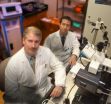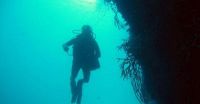(Press-News.org) Similar to humans, the bacteria and tiny plants living in the ocean need iron for energy and growth. But their situation is quite different from ours--for one, they can't turn to natural iron sources like leafy greens or red meat for a pick-me-up.
So, from where does their iron come?
New research results published in the current issue of the journal Nature Geoscience point to a source on the seafloor: minute particles of pyrite, or fool's gold, from hydrothermal vents at the bottom of the ocean.
Scientists already knew the vents' cloudy plumes, which spew forth from the earth's interior, include pyrite particles, but thought they were solids that settled back on the ocean bottom.
Now, scientists at the University of Delaware and other institutions have shown the vents emit a significant amount of microscopic pyrite particles that have a diameter 1,000 times smaller than that of a human hair.
Because the nanoparticles are so small, they are dispersed into the ocean rather than falling to the sea floor.
Barbara Ransom, program director in the National Science Foundation's (NSF) Division of Ocean Sciences, which funded the research, called the discovery "very exciting."
"These particles have long residence times in the ocean and can travel long distances from their sources, forming a potentially important food source for life in the deep sea," she said.
The project also received support from another NSF program, the Experimental Program to Stimulate Competitive Research, or EPSCOR.
The mineral pyrite, or iron pyrite, has a metallic luster and brass-yellow color that led to its nickname: fool's gold. In fact, pyrite is sometimes found in association with small quantities of gold.
Scientist George Luther of the University of Delaware explained the importance of the lengthy amount of time pyrite exists suspended in its current form in the sea, also known as its residence time.
Pyrite, which consists of iron and sulfur as iron disulfide, does not rapidly react with oxygen in seawater to form oxidized iron, or "rust," allowing it to stay intact and move throughout the ocean better than other forms of iron.
"As pyrite travels from the vents to the ocean interior and toward the surface ocean, it oxidizes gradually to release iron, which becomes available in areas where iron is depleted so that organisms can assimilate it, then grow," Luther said.
"It's an ongoing iron supplement for the ocean--much as multivitamins are for humans."
Growth of tiny plants known as phytoplankton can affect atmospheric oxygen and carbon dioxide levels.
Much of the research was performed by scientist and lead author Mustafa Yucel of the Universite Pierre et Marie Curie in France, conducted while Yucel worked on a doctorate at the University of Delaware.
It involved scientific cruises to the South Pacific and East Pacific Rise using the manned deep-sea submersible Alvin and the remotely operated vehicle Jason, both operated by the Woods Hole Oceanographic Institution.
INFORMATION:
Co-authors, in addition to Yucel and Luther, are Amy Gartman and Clara Chan, also of the University of Delaware.
'Fool's Gold' from the deep is fertilizer for ocean life
Pyrite nanoparticles from hydrothermal vents are a rich source of iron in the deep sea
2011-05-10
ELSE PRESS RELEASES FROM THIS DATE:
Sensitivity and Words - Radio Live365 "Robert Lauri On The Air"- The Public And Fans Participate In His Radio Programs
2011-05-10
Today, "Robert Lauri on the Air" Radio announced a new concept of radio interaction with the public. Fans, as well as the general listeners, can record a voice message online via a special radio webpage. They can express and share how they feel about a song or an album, about the artist, or any other musical topics they would like to discuss. The messages will be inserted into the Live365 radio programs that day, and as a result, the broadcast become a live show that changes daily due to listener participation and interaction with the artist. A special webpage ...
A tiltable head could improve the ability of undulating robots to navigate disaster debris
2011-05-10
VIDEO:
A team led by Georgia Tech School of Physics Assistant Professor Daniel Goldman has conducted physics and robotics experiments and created computer simulations to better understand how objects move through...
Click here for more information.
Search and rescue missions have followed each of the devastating earthquakes that hit Haiti, New Zealand and Japan during the past 18 months. Machines able to navigate through complex dirt and rubble environments could have ...
Nitric oxide impacts source of sickle cell pain crisis
2011-05-10
AUGUSTA, Ga. - Nitric oxide gas appears to directly impact the source of the classic, disabling pain crises of sickle cell disease, Georgia Health Sciences University researchers report.
The short-acting gas helps unglue hemoglobin molecules that stick together, forming long chains that ultimately deform red blood cells and prompting a cellular pileup in small blood vessels and pain, said Dr. C. Alvin Head, Chairman of GHSU's Department of Anesthesiology.
The findings get scientists closer to understanding why red blood cells sickle and potentially to a easy-to-use, ...
Model developed to improve combination vaccine accessibility worldwide
2011-05-10
Combination vaccines for young children are commonly used in industrialized nations because they provide protection for multiple diseases in one single injection. However, combination vaccines are prohibitively expensive for developing countries and may not available until several years later, or when market prices are more affordable.
As a result, the choice of vaccines used by developing and industrialized countries to immunize children against similar pediatric diseases is rapidly diverging.
A researcher at Rochester Institute of Technology has a solution. He developed ...
MIT news: New sensor can detect tiny traces of explosives
2011-05-10
CAMBRIDGE, Mass. - MIT researchers have created a new detector so sensitive it can pick up a single molecule of an explosive such as TNT.
To create the sensors, chemical engineers led by Michael Strano coated carbon nanotubes — hollow, one-atom-thick cylinders made of pure carbon — with protein fragments normally found in bee venom. This is the first time those proteins have been shown to react to explosives, specifically a class known as nitro-aromatic compounds that includes TNT.
If developed into commercial devices, such sensors would be far more sensitive than existing ...
Congresswoman Tammy Baldwin (D-WI) and Congressman Steven LaTourette (R-OH) Introduce the Community Access Preservation Act (CAP Act)
2011-05-10
Congresswoman Tammy Baldwin (D-WI) and Congressman Steven LaTourette (R-OH), jointly introduced legislation today that will help preserve Public, Educational and Government (PEG) access television channels across the country. The introduction of the Community Access Preservation Act (the CAP Act), was hailed by American Community Television (ACT) as critical to saving hundreds of channels as well as jobs in twenty states that passed statewide or state-issued franchising laws since 2005.
"ACT has been working with these offices and many others to create a solution ...
We actually 'become' happy vampires or contented wizards when reading a book
2011-05-10
BUFFALO, N.Y. -- Bad news for muggle parents! A new study by psychologists at the University at Buffalo finds that we more or less "become" vampires or wizards just by reading about them.
The good news is that, although we might think our teeth are a little sharper after a session with "Twilight," reading satisfies a deeply felt need for human connection because we not only feel like the characters we read about but, psychologically speaking, become part of their world and derive emotional benefits from the experience.
"Becoming a Vampire Without Being Bitten: The ...
More effective and less risky when you paint the hull of your boat
2011-05-10
Every boat owner recognises the dilemma: environmentally friendly or effective. Researchers at the University of Gothenburg have now found a way of reconciling these two almost unattainable aims. By using smart combinations of the most environmentally friendly biocides in the paint, it is possible to both reduce the total quantity of biocides and dramatically reduce the environmental impact.
"It's very easy to make an environmentally friendly hull paint, and just as easy to make an effective hull paint. Yet there is still no paint that is both effective and environmentally ...
Teenage alcohol consumption associated with computer use
2011-05-10
NEW YORK (May 9, 2011) -- Teenagers who drink alcohol spend more time on their computers for recreational use, including social networking
and downloading and listening to music, compared with their peers who don't drink.
Results of an anonymous survey of 264 teenagers were reported in the online edition of the journal Addictive Behaviors in a study authored by Weill Cornell Medical College public health researcher Dr. Jennifer Epstein.
"While the specific factors linking teenage drinking and computer use are not yet established, it seems likely that adolescents are ...
Genome of marine organism reveals hidden secrets
2011-05-10
An international team of researchers led by scientists at Scripps Institution of Oceanography at UC San Diego has deciphered the genome of a tropical marine organism known to produce substances potentially useful against human diseases.
Tiny photosynthetic microorganisms called cyanobacteria are some of the oldest forms of life on the planet. At times their emergence as toxic blooms causes a threat to humans and animals. But despite the recognized capability of marine strains of the cyanobacterial genus Lyngbya, and specifically the species L. majuscula, to create hundreds ...
LAST 30 PRESS RELEASES:
How to make AI truly scalable and reliable for real-time traffic assignment?
Beyond fragmented markets: A new framework for efficient and stable ride-pooling
Can shape priors make road perception more reliable for autonomous driving?
AI tracks nearly 100 years of aging research, revealing key trends and gaps
Innovative techniques enable Italy’s first imaging of individual trapped atoms
KIER successfully develops Korea-made “calibration thermoelectric module” for measuring thermoelectric device performance
Diversifying US Midwest farming for stability and resilience
Emphasizing immigrants’ deservingness shifts attitudes
Japanese eels, climate change, and river temperature
Pusan National University researchers discover faster, smarter heat treatment for lightweight magnesium metals
China’s 2024 Gastroenterology Report: marked progress in endoscopy quality and disease management
Pusan National University researchers uncover scalable method for ultrahigh-resolution quantum dot displays
Researchers use robotics to find potential new antibiotic among hundreds of metal complexes
Gut bacteria changes at the earliest stages of inflammatory bowel disease
Scientists develop new way to “listen in” on the brain’s hidden language
Brain research: “Pulse generators” grow and shrink as memories are formed
For teens, any cannabis use may have impact on emotional health, academic performance
School meals could unlock major gains for human and planetary health
Menopause hormone therapy does not appear to impact dementia risk
Signature patterns of brain activity may help predict recovery from traumatic brain injury
Dresden study uncovers new key mechanism in cancer cells
New species are now being discovered faster than ever before, study suggests
Cannabis-based products show limited short-term benefit for chronic pain, with increased risk of adverse effects
Cannabis products with more THC slightly reduce pain but cause more side effects
Clearing the brain of aging cells could aid epilepsy and reduce seizures
Brain injuries linked with potential risk of suicide, new study finds
New technique lights up where drugs go in the body, cell by cell
New study finds movement of fishing fleets can reveal shifts in marine ecosystems
Embargoed: New evidence points to potential treatment for vascular dementia
Study uncovers disrupted brain balance in alcohol dependence
[Press-News.org] 'Fool's Gold' from the deep is fertilizer for ocean lifePyrite nanoparticles from hydrothermal vents are a rich source of iron in the deep sea






